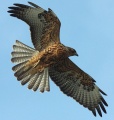m (Typo) |
|||
| Line 9: | Line 9: | ||
This is a [[Dictionary_M-O#M|monotypic]] species<sup>[[#References|[1]]]</sup>. | This is a [[Dictionary_M-O#M|monotypic]] species<sup>[[#References|[1]]]</sup>. | ||
| − | + | Its closest relative seems to be [[Swainson's Hawk]] | |
==Habitat== | ==Habitat== | ||
Revision as of 10:28, 22 April 2017
- Buteo galapagoensis
Identification
The adults are very dark, whereas the juvenile is quite mottled with pale eyes.
Distribution
There are just 800 of these magnificent birds left on the islands of the Galapagos.
Taxonomy
This is a monotypic species[1].
Its closest relative seems to be Swainson's Hawk
Habitat
Beach, bush, arid scrub and lava fields
Behaviour
Birds will throw sand up into the face of intruders.
Breeding
Many are polyandrous, whereby several males mate with a single female and stay around to help raise the young.
Gallery
Click on photo for larger image
References
- Clements, J. F., T. S. Schulenberg, M. J. Iliff, B.L. Sullivan, C. L. Wood, and D. Roberson. 2013. The eBird/Clements checklist of birds of the world: Version 6.8., with updates to August 2013. Downloaded from http://www.birds.cornell.edu/clementschecklist/download/
- BF Member observations
Recommended Citation
- BirdForum Opus contributors. (2024) Galapagos Hawk. In: BirdForum, the forum for wild birds and birding. Retrieved 29 April 2024 from https://www.birdforum.net/opus/Galapagos_Hawk






